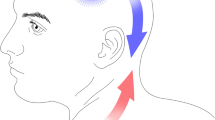Abstract
Myofascial pain is frequently overlooked in dealing with headache pain. Myofascial pain is defined as pain and/or autonomic phenomena referred from active trigger points, with associated dysfunction. The trigger point is a focus of hyperirritability in the muscle, that when compressed, is locally tender, and if sensitized, gives rise to referred pain and tenderness. The therapy for myofascial pain requires enhancing central inhibition through pharmacology or behavioral techniques and simultaneously reducing peripheral inputs through physical therapies including exercises and trigger point-specific therapy.
Similar content being viewed by others
References and Recommended Reading
Olesen J, Jensen R: Getting away from simple muscle contraction as a mechanism of tension-type headache. Pain 1991, 46:123–124.
Classification and diagnostic criteria for headache disorders, cranial neuralgias and facial pain. Headache Classification Committee of the International Headache Society [no authors listed]. Cephalalgia 1988, 8(suppl 7):1-96.
Schoenen J, Bottin D, Hardy F, Gerard P: Cephalic and extracephalic pressure pain thresholds in chronic tension-type headache. Pain 1991, 47:145–149.
Reeves JL, Jaeger B, Graff-Radford SB: Reliability of the pressure algometer as a measure of myofascial trigger point sensitivity. Pain 1986, 24:313–321.
Steinder A: The interpretation of the sciatic radiation and the syndrome of low back pain. J Bone Joint Surg 1940, 22:28–34.
Drewes AM, Jennum P: Epidemiology of myofascial pain, low back pain, morning stiffness and sleep related complaints in the general population [abstract]. J Musculoskeletal Pain 1995, 3(suppl 1):68.
Travell JG, Simons DG: Myofascial Pain and Dysfunction: The Trigger Point Manual. Baltimore: Williams and Wilkins; 1983.
Kellgren JH: Observations on referred pain arising from muscle. Clin Sci 1938, 3:175–190.
Kraft GH, Johnson EW, Laban MM: The fibrocytis syndrome. Arch Phys Med Rehabil 1968, 49:155–162.
Graff-Radford SB: Myofascial pain: an overview. Semin Anesth 1985, 4:281–286.
Fisher AA, Chang CH: Objective documentation of myofascial trigger points by thermography [abstract]. Pain 1984, 1(suppl):S137.
Simmons DS, Travell JG: Myofascial trigger points: a possible explanation. Pain 1981, 10:106–109.
Jaeger B, Reeves JL: Quantification of changes in myofascial trigger point sensitivity with pressure algometer following passive stretch. Pain 1986, 27:203–210.
Jaeger B, Skootsky SA: Double blind controlled study of different myofascial trigger point injections techniques [abstract]. Pain 1987, 4(suppl):S292.
Graff-Radford SB, Reeves JL, Chiu D: Effectiveness of transcutaneous electrical nerve stimulation on trigger point sensitivity. Pain 1989, 37:1–5.
Sola AE, Williams RL: Myofascial pain syndromes. Neurology 1956, 6:91–95.
Awad EA: Interstitial myofibrositis: hypothesis of the mechanism. Arch Phys Med 1973, 54:440–443.
Fassbender HG: Pathology of Rheumatic Diseases. New York: Springer-Verlag; 1975:303–304.
Mc Naaulty W, Gevirtz RN, Hubbard DR, Berkoff GM: Needle electromyographic evaluation of trigger point response to a psychological stressor. Psychophysiology 1994, 31:313–316.
Mense S: Referral of muscle pain new aspects. Pain Forum 1994, 3:1–9.
Mense S: Considerations concerning the neurobiological basis of muscle pain. Can J Physiol Pharmacol 1991, 9:610–616. This article helps to explain muscle pain referral.
Mense S: Nociception from skeletal muscle in relation to clinical muscle pain. Pain 1993, 54:241–289.
Simons DG: Neurophysiological basis of pain caused by trigger points. J Am Pain Soc J 1994, 3:17–19. This article serves to demonstrate the role muscle pain may play in myofascial pain from a clinical point of view.
Pedersen-Bjergaard U, Nielsen LB, Jensen K, et al.: Calcitonin gene related peptide, neurokinin A and substance P on nociception and neurogenic inflammation in human skin and temporal muscle. Peptides 1991, 12:333–337.
Fields HL, Heinricher M: Brainstem modulation of nociceptor-driven withdrawal reflexes. Ann N Y Acad Sci 1989, 563:34–44.
Olesen J: Clinical and pathophysiological observations in migraine and tension type headache explained by integration of vascular, supraspinal and myofascial inputs. Pain 1991, 46:125–132.
Ernberg M, Hadenberg-Magnusson B, Alstergren P, et al.: Pain, allodynia, and serum serotonin level in orofacial pain of muscular origin. J Orofac Pain 1999, 13:56–62.
Graff-Radford SB, Reeves JL, Jaeger B: Management of headache: the effectiveness of altering factors perpetuating myofascial pain. Headache 1987, 27:186–190.
Mennell JM: Spray-stretch for relief of pain from muscle spasm and myofascial trigger points. J Am Pod Assoc 1976, 66:873–876.
Jaeger B: Myofascial referred pain patterns: the role of trigger points. CDA J 1985, 13:27–32.
Graff-Radford SB: Treatment contracting for chronic pain patients. Los Angeles Psychologist 1999, 13:9–26.
Maitland GD: Vertebral Manipulation, edn 4. London: Butterworth; 1977.
Solberg WK: Temporomandibular disorders: masticatory myalgia and its management. Br Dent J 1986, 160:379–385.
Reeves JL: EMG-biofeedback reduction of tension headaches: a cognitive skills training approach. Biofeedback Self Regul 1976, 1:217–225.
Holroyd KA, Andresik F, Westbrook T: Cognitive control of tension headaches: a cognitive skills training approach. Cognitive Ther Res 1977, 1:121–133.
Sharav Y, Singer E, Schmidt E, et al.: The analgesic effect of amitriptyline on severe facial pain. Pain 1987, 31:199–203.
Fogelholm R, Murros K: Tizanidine in chronic tension type headache: a placebo controlled double blind cross over study. Headache 1992, 32:509–513.
Author information
Authors and Affiliations
Rights and permissions
About this article
Cite this article
Graff-Radford, S.B. Regional myofascial pain syndrome and headache: Principles of diagnosis and management. Current Science Inc 5, 376–381 (2001). https://doi.org/10.1007/s11916-001-0028-8
Issue Date:
DOI: https://doi.org/10.1007/s11916-001-0028-8




